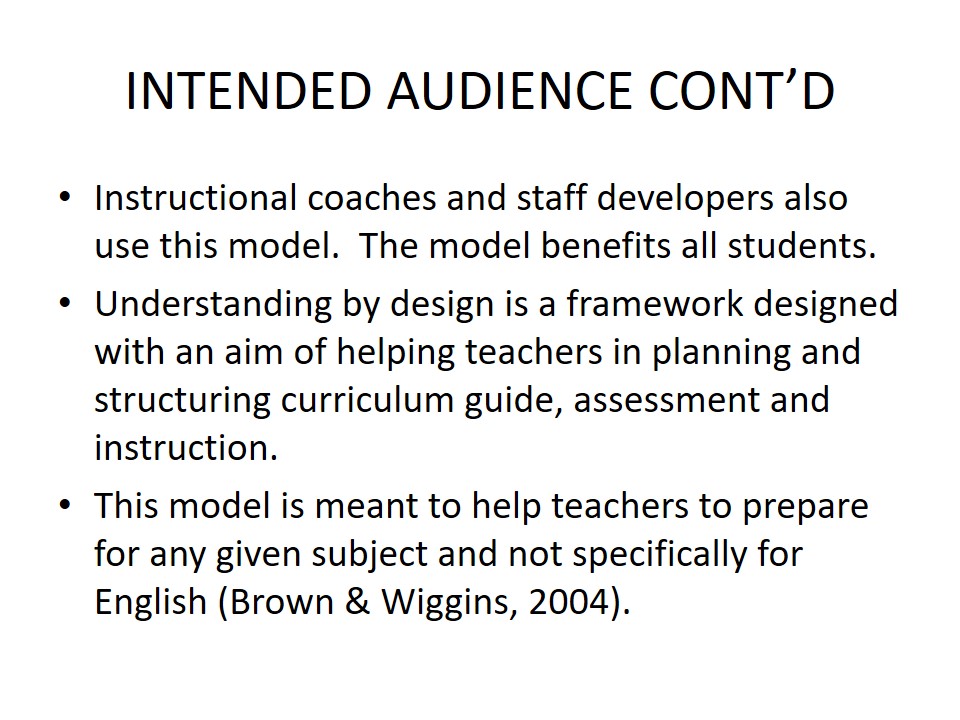Intended Audience
- SIOP and UBD are models and framework which guide teachers to plan their lessons. This model is research based and a validated instructional model.
- This model was intended for teachers of K-12 ESL, secondary content area and classrooms where the language is used in two-way immersion, and education faculty.
- Instructional coaches and staff developers also use this model. The model benefits all students.
- Understanding by design is a framework designed with an aim of helping teachers in planning and structuring curriculum guide, assessment and instruction.
- This model is meant to help teachers to prepare for any given subject and not specifically for English (Brown & Wiggins, 2004).


Underlying Theory
- Understanding by design is based on a theory that advocates for six factors as the standard measure of students’ understanding.
- These parameters are considered effective in luring students into demonstrating their level of understanding.
- They include; explanation, interpretation, application, perspective, empathy and self-knowledge (Brown & Wiggins, 2004).
- On the other hand, the underlying theory for SIOP advocates for application of eight components in testing understanding of students.
- These include; preparation, building background, having a comprehensible input, strategizing, interact ability, practicing, effective content delivery and review of the learnt lessons (Echevarria et al, 2008).


Context
- The perspective of UbD is focused towards promoting understanding of language among the students without applying formulas or ensuring recall.
- It is an entirely understanding-based framework of learning languages that seek to ensure achievement.
- Contrary, SIOP encompasses delivery by teachers and advocates for comprehensiveness to ensure both understanding and recall.
- This is evident since it advocates for use of models to ease understanding (Vogt & Echevarria, 2008).


Curricular Goals
The SIOP model was designed with an aim of helping educators to effectively teach English Language while UbD aims at enabling learners acquire fundamental skills and information in their area of study.

Approach to Unit Design
SIOP is research based while Design by understanding is backward design approach.

Approach to Lesson Design
SIOP model has eight components in preparation of lesson, background building, example input, strategies, interactions, application, and delivery of the lesson and assessment of the student understanding (Vogt & Echevarria, 2008).

Instructional Features
- UbD instructional features include; explanation, interpretation, application, perspective, empathy and self-knowledge (Wiggins & McTighe, 1998).
- On the other hand, SIOP has thirty features compressed into eight; preparation, building background, having a comprehensible input, strategizing, interact ability, practicing, effective content delivery and review of the learnt lessons.

Methods of Assessment
- SIOP model assessed students on the measure of their narrative and writing expository essays.
- The performance of students in their content area is another method of assessment in SIOP.
- UbD assesses based on six facets.
- The understanding of learners is demonstrated when students are able to use authentic opportunities to explain, interpret, apply, shift perspective, emphasize and self-assess (Echevarria et al, 2008).


Preferred mode
- I prefer UbD which aims at enabling learners acquire fundamental skills and information in their area of study.
- It is a model that can be used by teachers in different subjects apart from English hence it is a universal for several subject teachers.

References
- Brown, J. L., & Wiggins, G. P. (2004). Making the most of Understanding by design. Alexandria, Va.: Association for Supervision and Curriculum Development.
- Echevarria, J., Vogt, M., & Short, D. (2008). Making content comprehensible for English learners: the SIOP model (3rd ed.). Boston: Pearson/Allyn and Bacon.
- Vogt, M., & Echevarria, J. (2008). 99 ideas and activities for teaching English learners with the SIOP model. Boston: Pearson Allyn and Bacon.
- Wiggins, G. P., & McTighe, J. (1998). Understanding by design. Alexandria, Va.: Association for Supervision and Curriculum Development.